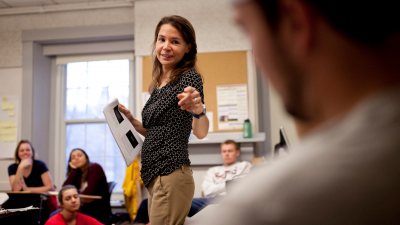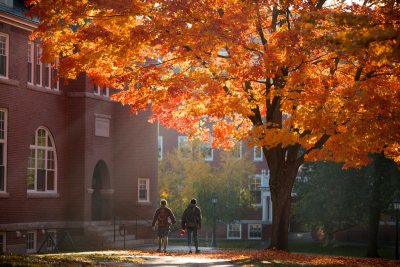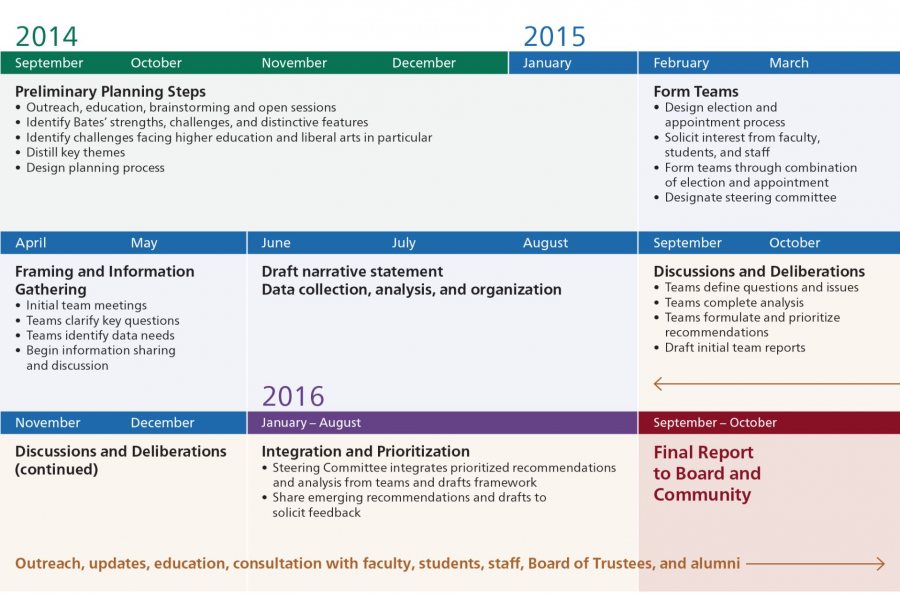Bates College Institutional Plan
Executive Summary
Goals
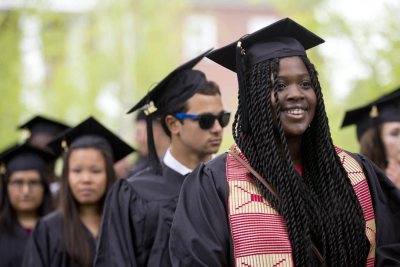 Institutional planning is conceived as a broad-based exercise designed to unlock the ideas and creativity of the Bates community. The goal of the process is to produce a framework of priorities that are collectively derived to guide the work of the college over the next five to eight years and to inform choices for a comprehensive fundraising campaign.
Institutional planning is conceived as a broad-based exercise designed to unlock the ideas and creativity of the Bates community. The goal of the process is to produce a framework of priorities that are collectively derived to guide the work of the college over the next five to eight years and to inform choices for a comprehensive fundraising campaign.
Throughout the institutional planning process, we have been mindful of our founding mission, our present strengths and weaknesses in higher education, and our ambitions for the future. Bates College was born from the exigencies of its historical moment. We are committed to engaging the future with rigor, imagination, and confidence. Today, and in the future imagined by this plan, we seek to:
- Provide a liberal arts experience that builds on our history, mission, and distinctive strengths while actively engaging the forces that are transforming higher education and the world.
- Achieve a more sustainable organizational and financial model commensurate with our ambitions.
- Raise the visibility of Bates as a powerful and innovative leader in the liberal arts.
This report is the product of many months of work by Bates faculty, staff, students, and trustees. It is at once the culmination of these efforts and the starting point for work that lies ahead for the entire campus community. It represents many hours of discussion, moments of passionate debate, and the decision-making that is possible only in a community of open, engaged, and thoughtful people of good faith who have deep devotion to the institution they share.
Process
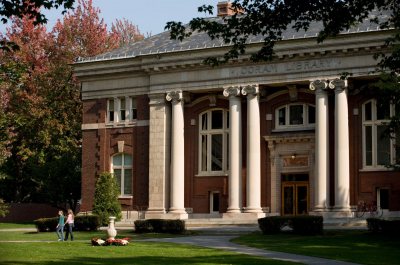 The planning process has spanned two academic years, beginning in the fall of 2014 as a series of conversations with students, faculty, staff, trustees, and alumni representatives, and extending through October 2016, when faculty and trustees were presented with the opportunity to consider and endorse the plan. The work of planning has been carried out by four working groups and a steering committee, comprising a total of 79 faculty, staff, and students. At intervals throughout the process, members of the Bates community have been invited to engage with the emerging ideas and recommendations and offer suggestions for change.
The planning process has spanned two academic years, beginning in the fall of 2014 as a series of conversations with students, faculty, staff, trustees, and alumni representatives, and extending through October 2016, when faculty and trustees were presented with the opportunity to consider and endorse the plan. The work of planning has been carried out by four working groups and a steering committee, comprising a total of 79 faculty, staff, and students. At intervals throughout the process, members of the Bates community have been invited to engage with the emerging ideas and recommendations and offer suggestions for change.
The Plan
The document that follows establishes a framework of priorities to guide Bates for the next five to eight years, identifying both short- and long-term goals. It details areas where we know we need to build strength and where significant work is underway. It also commits us to a set of concrete actions, to begin immediately, that will inform the upcoming comprehensive fundraising campaign. Finally, it points to important, longer-term structural issues that need to be further examined in order to make progress.
The document is not, nor should it be, a business plan. Because we operate through a system of shared governance, with faculty, staff, students, trustees, and alumni playing a role in decision- making, this framework of priorities is meant to be flexible and dynamic, evolving over time, and informed by appropriate governance processes. Within each of the categories, responsibility for progress on specific issues or action items falls under the purview of different members of the senior staff, standing faculty committees that are part of existing governance structures, or future ad hoc committees that will be appointed as needs arise. These individuals and committees will develop detailed plans and timetables for sequencing the activities called for in the plan.
Values and Aspirations
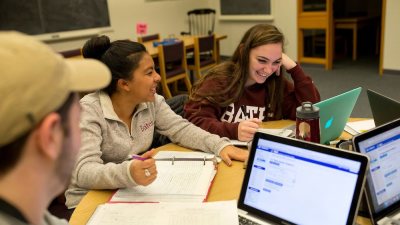 From the beginning of the institutional planning process, our goal was to ground the planning effort in our fundamental values, our distinctive history, and our commitment, from our founding, to be open to the world and the future, even as we affirm the power and efficacy of the residential liberal arts experience. Building on the mission statement enacted in 2010, the text that became “Values and Aspirations” was the first piece of work we undertook and is meant to serve as a foundation for the report. Developed over the period of a year and in extensive consultation with the Bates community, this section describes our institutional values, the aims of a Bates education, the Bates model, and a way forward.
From the beginning of the institutional planning process, our goal was to ground the planning effort in our fundamental values, our distinctive history, and our commitment, from our founding, to be open to the world and the future, even as we affirm the power and efficacy of the residential liberal arts experience. Building on the mission statement enacted in 2010, the text that became “Values and Aspirations” was the first piece of work we undertook and is meant to serve as a foundation for the report. Developed over the period of a year and in extensive consultation with the Bates community, this section describes our institutional values, the aims of a Bates education, the Bates model, and a way forward.
Summary of Priorities
1. Constituting Community
Cultivate a community that supports Bates’ distinctive approach to education and ensures the success of all members.
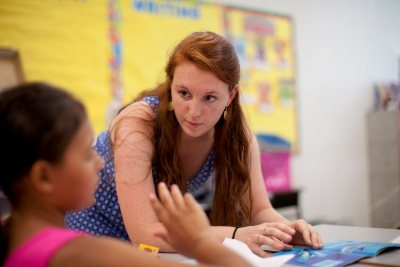 A Bates education is realized in community. We build our community with care and attention, seeking individuals—students, faculty, and staff—who will together create a whole that is greater than the sum of its parts. We believe that community is strongest when it embodies a broad spectrum of human experience, and the Bates community is consciously constructed with an eye toward diversity of experience and background. These values inform our recruitment and admission of students, as well as our hiring of faculty and staff. Once we have welcomed new members into our community, we are committed to supporting them in every way to ensure their success.
A Bates education is realized in community. We build our community with care and attention, seeking individuals—students, faculty, and staff—who will together create a whole that is greater than the sum of its parts. We believe that community is strongest when it embodies a broad spectrum of human experience, and the Bates community is consciously constructed with an eye toward diversity of experience and background. These values inform our recruitment and admission of students, as well as our hiring of faculty and staff. Once we have welcomed new members into our community, we are committed to supporting them in every way to ensure their success.
The Bates community extends beyond our campus: to alumni who have taken their Bates experience out into the world, to the parents and families who make the Bates experience possible for our students, to our neighbors in Lewiston and Auburn, to our current students pursuing their education globally, and to our colleagues and peers around the world. The centrality of community to the Bates experience manifests itself in the extensive community-engaged work of our students, faculty, and staff, as well as in the intellectual connections we create and maintain to enhance our understanding of people and places beyond our physical reach.
BUILDING ON STRENGTHS
- 1.1 Invest in student recruitment and financial aid and create and sustain an inclusive campus community.
- 1.2 Invest in the college’s intellectual vitality by adding faculty lines and ensuring appropriate compensation.
- 1.3 Shape the next generation of excellent faculty with a commitment to diversity.
- 1.4 Create structures and practices that support faculty throughout their careers.
- 1.5 Strengthen the integration of staff into the intellectual life of Bates.
- 1.6 Engage alumni and families more fully with the life of the college.
CHARTING NEW DIRECTIONS
- 1.7 Examine and strengthen support for the economic, social, and cultural experiences of all members of the campus community.
- 1.8 Ensure that organizational structures adequately support our educational programs and promote the intellectual vibrancy of the college.
2. Enhancing the Academic Experience
Offer an academic experience that aligns with Bates’ mission and values.
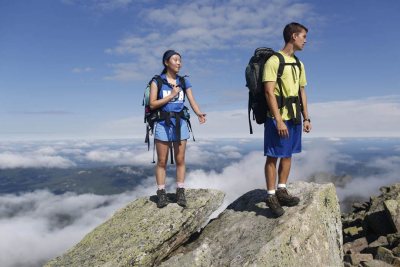 We offer a model of liberal arts education rooted in our distinctive history and mission and centered on rigorous intellectual engagement in the context of deep and sustained interactions among students, faculty, and community. We also actively engage the forces—intellectual trends, demographic changes, and technology—that are transforming higher education and the world into which our students graduate. We make a virtue of our small scale, creating a diverse and motivated community of teachers and learners who embrace innovative and evidence-based approaches to education. We strive to ensure that all of our programs reflect the diversity in our community.
We offer a model of liberal arts education rooted in our distinctive history and mission and centered on rigorous intellectual engagement in the context of deep and sustained interactions among students, faculty, and community. We also actively engage the forces—intellectual trends, demographic changes, and technology—that are transforming higher education and the world into which our students graduate. We make a virtue of our small scale, creating a diverse and motivated community of teachers and learners who embrace innovative and evidence-based approaches to education. We strive to ensure that all of our programs reflect the diversity in our community.
BUILDING ON STRENGTHS
- 2.1 Elevate a culture that promotes creativity, intentionality, and reflection in teaching and learning.
- 2.2 Support all students for academic success.
- 2.3 Create a unified physical space for the Academic Resource Commons (ARC).
- 2.4 Strengthen our support for rigorous scholarship.
- 2.5 Strengthen our institutional commitment to community-engaged learning, research, and practice.
- 2.6 Support the arts as a core element of the liberal arts experience.
- 2.7 Engage critically with technology as a force reshaping intellectual work and social relations.
- 2.8 Optimize Short Term as a distinguishing feature of a Bates education.
- 2.9 Integrate global education off-campus with campus, curricular, and community work.
CHARTING NEW DIRECTIONS
- 2.10 Develop a model of general education that achieves our educational goals.
- 2.11 Fortify the distinctive elements of science education at Bates.
- 2.12 Build new science facilities to support our ambitions in science education.
- 2.13 Implement the new program and major in Digital and Computational Studies.
- 2.14 Create a multidisciplinary institute focused on questions or topics of societal importance.
3. Educating the Whole Person
Educate the whole person by supporting the integration of intellectual and personal growth across a student’s four years at Bates.
A critical component of educating the whole person is the process through which students become aware of their interests, community, and purpose in the world Bates fosters a residential campus culture that encourages agency, exploration, and reflection for all students and supports the integration of intellectual and personal growth throughout their four years at Bates.
BUILDING ON STRENGTHS
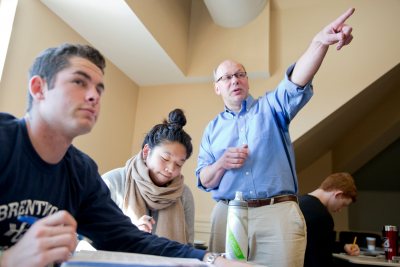 3.1 Create a more coherent and intentional approach to the student experience that promotes reflection among students and greater self-awareness of their trajectory through Bates.
3.1 Create a more coherent and intentional approach to the student experience that promotes reflection among students and greater self-awareness of their trajectory through Bates.- 3.2 Strengthen institutional support for athletics for students, faculty, and staff at all levels of participation and ensure that this important area of the college has an inclusive climate and is welcoming to all.
- 3.3 Reinforce our commitment to the natural world and environmental sustainability in the operations of the institution and in the promotion of environmentally sound practices of members of our community.
CHARTING NEW DIRECTIONS
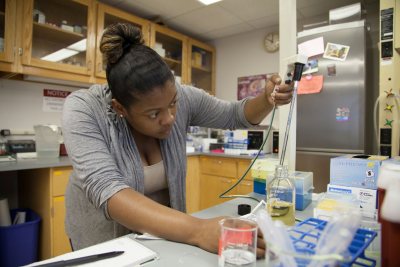 3.4 Promote Purposeful Work as a distinguishing element of the Bates experience and seek ongoing funding for the program.
3.4 Promote Purposeful Work as a distinguishing element of the Bates experience and seek ongoing funding for the program.- 3.5 Provide students with resources to maintain the health and wellness necessary to achieve academic and personal success during their time at Bates and beyond, paying special attention to the differentiated needs of students with disabilities and from other marginalized groups.
- 3.6 Optimize facilities that support student services, co-curricular endeavors, and social life.
4. Strengthening Financial Sustainability
Achieve a stronger and more sustainable financial base commensurate with our ambitions.
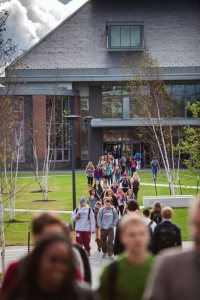 For Bates, achieving a more robust and sustainable organizational and financial model is a key strategic imperative. Our financial model must ensure a diverse portfolio of students who can afford to attend and adequate capacity to support the education we aspire to provide, with appropriate staff and facilities. It must also include an elevated culture of philanthropy that provides a meaningful revenue stream year after year.
For Bates, achieving a more robust and sustainable organizational and financial model is a key strategic imperative. Our financial model must ensure a diverse portfolio of students who can afford to attend and adequate capacity to support the education we aspire to provide, with appropriate staff and facilities. It must also include an elevated culture of philanthropy that provides a meaningful revenue stream year after year.
BUILDING ON STRENGTHS
- 4.1 Maximize the financial sustainability and revenue orientation of the college.
- 4.2 Maintain consistent and appropriate investment to address deferred maintenance needs.
- 4.3 Prioritize investments in technology infrastructure.
- 4.4 Rigorously evaluate new proposals that entail significant expenditures to ensure that they are aligned with key college priorities.
- 4.5 Explore institutional collaborations.
- 4.6 Leverage resources efficiently and maximize the flexibility of physical resources.
Values and Aspirations
Our mission statement, adopted in 2010, serves as the touchstone for the institutional planning process:
Since 1855, Bates College has been dedicated to the emancipating potential of the liberal arts. Bates educates the whole person through creative and rigorous scholarship in a collaborative residential community. With ardor and devotion— Amore ac Studio—we engage the transformative power of our differences, cultivating intellectual discovery and informed civic action. Preparing leaders sustained by a love of learning and a commitment to responsible stewardship of the wider world, Bates is a college for coming times.
Values
Bates College was built by people who put their ideals into action and in whose hands the liberal arts served as a dynamic force for the public good. With their progressive call, in 1855, to admit African Americans and to educate men and women together, the founders of Bates affirmed that all human potential deserves to be developed. This radical, founding moment manifested a durable instinct for the fellowship of learning that continues to guide our commitment to intensive and unfettered humanistic inquiry.
Plainly, no institution can ever fully live up to its ideals. At times our efforts have fallen short in achieving our goals of access and full participation for women and racial and ethnic minorities. The institutional planning process invites us to ask ourselves, first, where we are failing to deliver on our promise, and, second, how best we can build on strengths and embrace opportunities to shape a strategic way forward. Bates’ longstanding principles of inclusion have become only more essential in a highly interconnected world. We recognize an abiding moral imperative for broad access, and we also value diversity as essential to the vitality of our educational mission. Our commitment to these values is capacious, seeking to increase embodied diversity and to improve all aspects of the Bates experience—the curriculum, teaching and learning, and campus life.
Likewise, other deeply held principles of the liberal arts tradition, including commitment to rigor, unhindered inquiry, and the free exchange of ideas, have particular salience in a knowledge-driven society. Today, as in 1855, the college’s values of inclusion, inquiry, and exchange offer a compelling vision of human possibility.
The Bates residential model reflects our fundamental purpose—to educate the whole person—and our conviction that this purpose is best realized in community. In a world where work and personal relationships are increasingly remote and disembodied, a Bates education is rooted in place and in the powerful diversity of human connection. The physical spaces at Bates are meant to be catalysts for both authentic interaction and intentional reflection, places where ideas grow through introspection, collaboration, and debate.
Finally, an important part of what makes us distinctive is the recognition, embedded in our mission’s appeal to “coming times,” that no institution remains vital, or even viable, if it stands still. In our best moments and in our driving ideals, we lead as a forward-thinking community of scholars, students, teachers, staff, and alumni, inviting in the future as a source of strength and vitality. Our constant challenge is to translate these animating values into the liberal arts education we provide to each generation of our students.
The Aims of a Bates Education
In 1894, Bates’ second president, George Colby Chase, wrote that the aim of the college should be to produce graduates whose “education shall have prepared them to live in every chamber of their being, to be at home in the world as the world presents itself today, and to be master of … the opportunities that the many-sided life of our age may offer.” This vision of the liberal arts as a deeply humanistic, yet powerfully adaptive and pragmatic, model of education underlies our approach to preparing our students for life, work, and social contribution. It is a model that draws equally from all areas of scholarly inquiry. In particular, a Bates education aims to prepare graduates who strive to embody the following qualities, capabilities, and inclinations:
Knowledge, Problem Solving, Analytic Strength
To engage deeply with fields of study and acquire the habits of inquiry, the confidence, and the capacity to define and confront challenges with competence and creativity. Amidst a chaos of information, to derive patterns, knowledge, and understanding.
Discernment and Persuasion
To think critically, contextually, creatively, and conceptually. To reason from evidence and to present ideas and evaluate arguments effectively.
Intellectual Curiosity
To embrace the power of ideas, the joy of learning, and informed engagement with our rich and complex world. To recognize differences in thought and experience as inevitable and valuable.
Social Commitment and Integrity
To strive for justice. To act based on the recognition of the importance of community, our shared humanity, and our common stake in the natural world. To live an examined life with courage and tenacity.
The Bates Model
Bates offers a model of the liberal arts that delivers a high-quality education centered on deep, sustained interactions among students, faculty, staff, and community, while engaging the forces that are transforming higher education and the world. This model depends on recognizing the strength, wholeness, and potential of every individual and building a community that embraces differences in thought and experience as sources of power and effectiveness.
Our faculty provide the foundation for this model. Through their teaching, scholarship, and artistic work, they inspire students to take ideas seriously and to love them. They help students when texts resist interpretation and when scientific or creative experiments fail. Faculty-student mentoring, senior thesis, and collaboration on research and course design are successful because of our intimate scale and our commitment to innovative and evidence- based approaches to teaching and learning. By facilitating the widest range of faculty-student interactions—both formal and informal—Bates catalyzes deep learning and transformation, as well as lifelong connections to the college community.
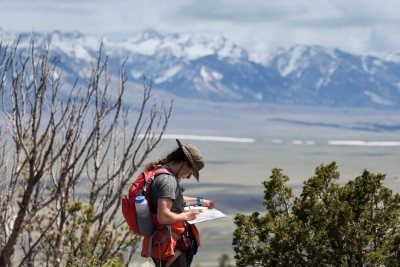 We seek to educate the whole person, both within the classroom and beyond, and we enlist all members of the Bates community in this project. Our challenge, met more successfully in some areas than others, is to highlight intellectual connections between the curriculum at Bates, the global learning opportunities with which our students engage, and broader campus experiences in clubs, athletics, the making and performance of art, community engagement, and participation in outdoor life. We also seek to cultivate an intentional approach to internships and study abroad, as well as alumni and parent participation in an educational experience that encompasses both personal well-being and professional success.
We seek to educate the whole person, both within the classroom and beyond, and we enlist all members of the Bates community in this project. Our challenge, met more successfully in some areas than others, is to highlight intellectual connections between the curriculum at Bates, the global learning opportunities with which our students engage, and broader campus experiences in clubs, athletics, the making and performance of art, community engagement, and participation in outdoor life. We also seek to cultivate an intentional approach to internships and study abroad, as well as alumni and parent participation in an educational experience that encompasses both personal well-being and professional success.
This model of active learning and problem- solving extends beyond our campus. Bates is a national leader in community-engaged learning. The work of our students and faculty in the city of Lewiston and around the world is based on the conviction that bringing theory to practice, and practice to theory, enriches theoretical frameworks even as it creates powerful tools for solving real-world problems. The landscapes of Maine, with their unique communities and natural resources, invite our engagement and fieldwork. Our students, staff, and faculty form partnerships in Lewiston and beyond through their curricular and co-curricular work, focusing on the lives and places we share and reinforcing the centrality of community to the Bates experience.
We recognize that the future of the liberal arts will increasingly play out in the context of global competition for talent and for the development of effective educational models. Many aspects of the Bates experience reflect this globalized reality. Our student body is international. Among our peer institutions we are also a leader in student global off-campus study, a great majority of our students work abroad, and we are a top-producing Fulbright institution. Many of our faculty collaborate with colleagues across the world in their research and teaching, and many are internationally recognized scholars who have contributed to and expanded global conversation on diverse topics.
Pointing a Way Forward
In our founding and in our mission, we bound ourselves to be open to the world and to the future, even as we affirmed the distinctive values and efficacy of the residential liberal arts model. The institutional planning process invites us to consider these commitments in the present moment in order to discipline our choices and chart a sound and ambitious course for the next period of time.
The planning process requires that we do our best to imagine our future course in light of the context in which we find ourselves—the rapid rate of change in the world, the explosion of fields of knowledge, cultural and demographic trends and their implications for who makes up our community and how we function, the role of technology in learning and social relations, the economics of higher education, and the complexities of global interconnectedness. With these considerations in mind, the plan that follows aims to balance fidelity to the defining principles of the liberal arts and our own distinctive identity with an openness to innovation and adaptation in everything we do—in our research and teaching, in the way we support students and faculty, in the way we build community, in the way we administer our programs, and in the business functions of the college.
As we come together to consider Bates’ future, we have compelling opportunities and many reasons for optimism. The small scale and residential character of the liberal arts college is a powerful advantage in a knowledge-driven and networked world, where information, texts, artistic works, and primary sources are broadly available. In access to knowledge and materials, small liberal arts colleges like Bates now enjoy many of the benefits that used to be reserved for large research universities. Furthermore, students need more guidance than ever in navigating the clamor of information coming at them in ways that are intellectually sound, ethically defensible, and preserving of personal well-being and social responsibility. The residential model is particularly powerful when our task is understood not as the transmission of information and knowledge alone, but as the education of the whole person.
Our strength comes not only from being a liberal arts college, but also from being the particular college we are. Our long-standing commitments to critical inquiry and inclusiveness are potent tools as we prepare students for life in a pluralistic world. At a time when higher education turns increasing attention to how students learn, the quality of student-faculty interaction in the classroom and on research—and our commitment to teaching innovation—are distinguishing strengths. Additionally, current faculty demographics provide an important occasion for collective action and an unprecedented opportunity to think strategically about how we will shape our curriculum and build our community for the years ahead.
In the decades to come, success will go to the institutions that know who they are and how to engage effectively with the forces that are shaping our world. Bates intends to be among the vanguard.
Priorities
Priority 1. Constituting Community
Cultivate a community that supports Bates’ distinctive approach to education and ensures the success of all members.
A Bates education is realized in community. We build our community with care and attention, seeking individuals—students, faculty, and staff—who will together create a whole that is greater than the sum of its parts. We believe that community is strongest when it embodies a broad spectrum of human experience, and the Bates community is consciously constructed with an eye toward diversity of experience and background. These values inform our recruitment and admission of students, as well as our hiring of faculty and staff. Once we have welcomed new members into our community, we are committed to supporting them in every way to ensure their success.
The Bates community extends beyond our campus: to alumni who have taken their Bates experience out into the world, to the parents and families who make the Bates experience possible for our students, to our neighbors in Lewiston and Auburn, to our current students pursuing their education globally, and to our colleagues and peers around the world. The centrality of community to the Bates experience manifests itself in the extensive community-engaged work of our students, faculty, and staff, as well as in the intellectual connections we create and maintain to enhance our understanding of people and places beyond our physical reach.
BUILDING ON STRENGTHS
Students
1.1 Invest in student recruitment and financial aid and create and sustain an inclusive campus community.
Bates is committed to building a student body that is diverse across many dimensions— demographic, socio-economic, intellectual interest, perspective, and post-college aspiration—and to providing students the support they need to succeed in college and beyond. This commitment is grounded in our ethical obligation to make sure that the opportunity to attend Bates is available to talented students regardless of their families’ financial circumstances, and it is reinforced by the imperative that we prepare our students for life in a pluralistic world.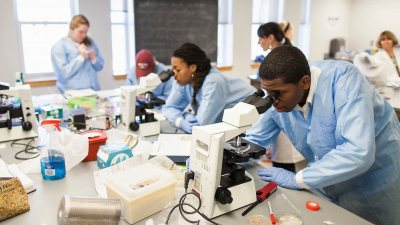
We recommend that Bates expand its commitment to access and affordability through significant investment in the areas of admission and financial aid and fundraising to provide the resources that will allow us to be a college where talented students with a broad range of interests and experiences are welcomed, challenged, and supported.
Faculty
1.2 Invest in the college’s intellectual vitality by adding faculty lines and ensuring appropriate compensation.
Every time Bates hires a new faculty member, the college makes a thirty- to forty-year investment in the continuing excellence of the liberal arts education we provide. The faculty is the cornerstone of this educational experience, and to sustain it we need to make a significant commitment to faculty expansion and compensation.
Given the rapid proliferation of knowledge and the ceaseless emergence of new fields and sub fields of inquiry, it is a challenge for any college or university, but especially for a small liberal arts college, to offer a broad curriculum. Bates has a particular challenge in this regard, as to date we have diversified our academic offerings—from 17 academic departments in 1990 to 32 departments and programs in 2016—largely through faculty volunteerism rather than direct financial investment in expansion of the faculty. Accordingly, as we move into a comprehensive fundraising campaign, we propose that Bates place an explicit and high priority on raising funds to expand the faculty and to invest in appropriate compensation and support for research and professional development for all of our faculty.
1.3 Shape the next generation of excellent faculty with a commitment to diversity.
With a large fraction of our current faculty reaching retirement during the current decade, Bates has a once-in-a-generation opportunity to shape the faculty that will anchor the college until mid-century. We recommend that Bates build this faculty by increasing its overall size (as detailed in Action 1.2) and making strategic decisions about how to redeploy existing resources as faculty retire.
In considering the future shape of the faculty, we recognize that an excellent faculty in the 21st century is, by definition, a diverse faculty, and we need to prioritize diversity in hiring. Significant efforts in this regard are already underway. Bates currently has two Mellon- funded initiatives in place aimed at diversifying the faculty. Both of these grants provide postdoctoral fellowship opportunities aimed at mentoring young scholars as they move from graduate school to teaching in liberal arts colleges. One of these grants is tied to the renewal of tenure track lines.
We also recognize that the velocity of change in the world, shifting demographics, globalization, the explosion of knowledge, and increasing interdisciplinarity have implications for how and what we teach at Bates. Accordingly, as we renew our faculty, we need to seek individuals who are committed to teaching undergraduates and are well-versed in pedagogies that encourage full participation by all students in the classroom.
At the structural level, in 2014, the faculty created a new governing body, the Academic Affairs Council (AAC), which includes the Dean of the Faculty and the faculty chairs of the college’s four academic divisions. This structure brings together, for the first time, responsibility for questions of curriculum and educational policy with decision-making authority about faculty resources. In so doing, it provides the AAC with the mandate to place individual decisions about faculty line allocation in the context of a broader vision of the ultimate faculty we are trying to achieve.
1.4 Create structures and practices that support faculty throughout their careers.
We propose that Bates strengthen its intellectual culture by more intentionally and effectively supporting faculty at every stage of their careers. This support should include, among other things, cultivating awareness of the differentiated experiences of Bates faculty from underrepresented groups and creating systems and structures for meeting their particular needs.
Prior to tenure and promotion, Bates invests significant time and resources in ensuring the success of each individual faculty member through formal and informal development and support programs as well as start-up and conference travel funds, access to competitively awarded faculty scholarship grants, and pre- sabbatical leave, among other resources. These efforts are reinforced by a highly structured set of procedures for evaluating performance from the point of initial hire through the tenure decision.
Although many enabling resources remain available to faculty members post-tenure, they are less focused and effective. We propose that Bates create more effective mentoring and targeted professional development programs following the tenure decision to support the needs of faculty who are contemplating new subjects or directions in their teaching, scholarship, service to Bates, or publicly- engaged work. Examples of such programs could include more intentional, mid-career professional workshops focusing on grants, research impact, and visibility; a structured series of meetings with the Dean of the Faculty to discuss current or future research plans; and support for collaborative scholarship among faculty. Such programs would ensure that faculty members have robust professional development support that adapts to their changing needs and enables them to remain fully engaged participants in the life of the college.
Recognizing that faculty have different experiences based on race, gender identity, disability, and more, we recommend that the college explore how it might better support faculty through their careers at Bates and build a culture of awareness around the notion that different people experience our campus and their work here in different ways. One example of this work already underway is the development of a Colby/Bates/Bowdoin collaborative for faculty of color.
Staff
1.5 Strengthen the integration of staff into the intellectual life of Bates.
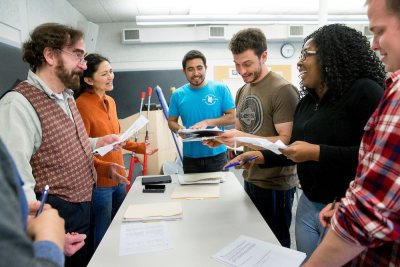 The vibrant network of relationships among all members of the Bates community is a core element of the education we offer. We recognize that the experiences, expertise, and genuine care for and interest in our students that our staff bring to their work at Bates are often as influential and transformative to the experiences of our students as the formal education they receive in our classrooms, studios, and labs. Indeed, staff provide much- needed support as an intellectual resource in these formal settings and as friends and mentors in informal settings on campus such as Commons and the residence halls.
The vibrant network of relationships among all members of the Bates community is a core element of the education we offer. We recognize that the experiences, expertise, and genuine care for and interest in our students that our staff bring to their work at Bates are often as influential and transformative to the experiences of our students as the formal education they receive in our classrooms, studios, and labs. Indeed, staff provide much- needed support as an intellectual resource in these formal settings and as friends and mentors in informal settings on campus such as Commons and the residence halls.
Our educational model is premised on the notion that learning happens in community and is most powerful when it is marked by collaboration, self-discovery, rigor, and exploration on the part of all members of a community. These values find expression in our existing professional development opportunities, in our educational assistance program for staff taking courses elsewhere, and in our robust Bates Enrichment Week, held at the end of each academic year. We recommend that Bates build on existing efforts not only by emphasizing individual opportunities for staff, but also by creating a culture that more organically and meaningfully integrates staff into the intellectual life of the institution.
Alumni and Families
1.6 Engage alumni and families more fully with the life of the college.
The extended Bates community is vital to the long-term success of the institution and indispensable to our efforts to link our students’ experiences during their four years here with longer-term career and life goals. Over the past several years, Bates has greatly increased its focus on alumni and parent programs with the goal of creating broader and longer- lasting engagement with the college. We have also focused on educating students about the alumni life-cycle and increased age- and affinity-specific programming on campus and at regional events across the country. Bates has also recently begun to call on our alumni and parents as important sources of expertise and mentoring for our students in the classroom and in the realms of career exploration and internships.
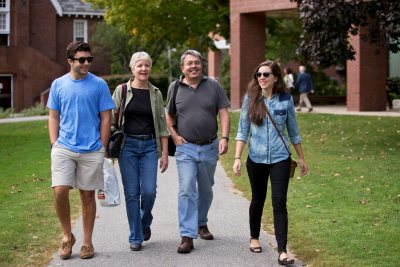
We recommend that, over the next five to eight years, Bates continue to prioritize the building of a durable platform for engagement with parent and alumni networks, including those for underrepresented groups, and the development of a culture of philanthropy at Bates that extends from students’ days on campus through their alumni years. The upcoming campaign will provide a natural opportunity to reinforce engagement and philanthropy, and it will be crucial that we emerge from the campaign with a sustainable structure for the future.
CHARTING NEW DIRECTIONS
1.7 Examine and strengthen support for the economic, social, and cultural experiences of all members of the campus community.
We are committed to fostering a living and learning environment in which all students can thrive. This commitment requires that we continually assess campus climate and culture and take necessary steps to address problems. Where we understand there to be barriers to full participation in academic or campus life, we must develop interventions that take into account the ways in which a student’s economic, social, or cultural background may influence their experience at Bates or impede their ability to thrive.
Over the past two years, under the auspices of a revitalized Office of Intercultural Education, we have made significant progress in designing and implementing programs that support students of color, students who are first in their families to attend college, and students who are LGBTQA+ identified. We recommend that the college build on these efforts by identifying ways that the principles and actions supporting inclusion can be integrated more broadly across campus. We further recommend that the college continue to develop and support those areas of the campus specifically focused on supporting students from underrepresented groups and their allies.
1.8 Ensure that organizational structures adequately support our educational programs and promote the intellectual vibrancy of the college.
In theory, the organization of a college’s academic units and its structures for evaluating and rewarding faculty work should provide support for its collective intellectual enterprise: fostering a transformative educational experience for students, nourishing the scholarly endeavors of faculty over the arc of their careers, and integrating members and visitors into the exhilarating pursuit of knowledge. Too often, however, the administrative demands of our current academic organization and the reward structures for faculty work hinder rather than foster pedagogical innovation, enervate rather than enliven faculty development, and silo rather than integrate our educational community.
Over time, Bates has responded to the evolution of intellectual fields and changes in student interests in part by adding new majors and programs on top of a traditional department- based organizational structure. 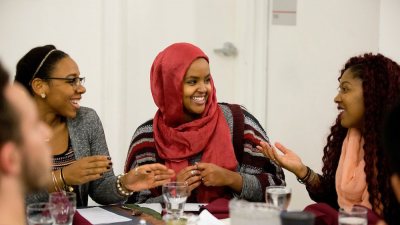
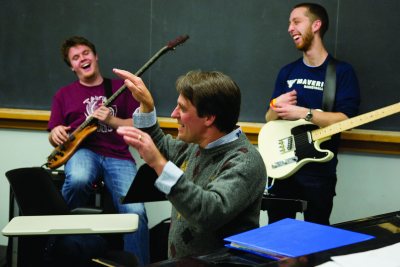 This piecemeal addition of academic units—motivated by our deep commitment to intellectual innovation— has added complexity, inconsistency, and opacity to the college’s academic structure, and placed differential burdens on faculty and students in some areas. As we undertake a review of our general education program, the Academic Affairs Council should be open to the possibility that current department and program structures may need to adapt and change, as well. Such modifications, if any, should aim to better sustain our faculty, support our curriculum, and redirect energy toward the collective intellectual life of the college. A similarly open-minded consideration of faculty reward structures in relation to the college’s current institutional mission, values, and priorities is also encouraged.
This piecemeal addition of academic units—motivated by our deep commitment to intellectual innovation— has added complexity, inconsistency, and opacity to the college’s academic structure, and placed differential burdens on faculty and students in some areas. As we undertake a review of our general education program, the Academic Affairs Council should be open to the possibility that current department and program structures may need to adapt and change, as well. Such modifications, if any, should aim to better sustain our faculty, support our curriculum, and redirect energy toward the collective intellectual life of the college. A similarly open-minded consideration of faculty reward structures in relation to the college’s current institutional mission, values, and priorities is also encouraged.
Priority 2. Enhancing the Academic Experience
Offer an academic experience that aligns with Bates’ mission and values.
We offer a model of liberal arts education rooted in our distinctive history and mission and centered on rigorous intellectual engagement in the context of deep and sustained interactions among students, faculty, and community. We also actively engage the forces—intellectual trends, demographic changes, and technology—that are transforming higher education and the world into which our students graduate. We make a virtue of our small scale, creating a diverse and motivated community of teachers and learners who embrace innovative and evidence-based approaches to education. We strive to ensure that all of our programs reflect the diversity in our community.
BUILDING ON STRENGTHS
2.1 Elevate a culture that promotes creativity, intentionality, and reflection in teaching and learning.
Liberal arts colleges, because of their small scale and exclusive focus on undergraduates, have rightly claimed the quality of the teaching and learning that happens on our campuses as a distinguishing feature of the educational experience we offer. At Bates, the intensity and quality of the learning that takes place between our dedicated faculty and curious and motivated students has been a distinguishing feature of the educational experience for generations. We recommend that Bates build on this foundation to strengthen our position as a leader in teaching excellence.
For this project, we have an increasingly powerful set of tools available to us, given recent advances across higher education in our understanding of the brain, in our insight into learning processes across individuals and in different stages of development, and in the design and measurement of different pedagogical techniques. Accordingly, we recommend that Bates take a highly intentional approach to promoting excellence in teaching and learning that is grounded in our own experience and informed by research and best practices gleaned from the field.
Important efforts are already underway under the leadership of the Faculty Commons—New Faculty Orientation, first-year writing programs, and Short Term (Re)design courses. These programs develop pedagogical innovations that are inclusive and enable the deployment of curricula that value the assessment of student learning. The Faculty Commons should have as a central goal the unification, expansion, and creation of efforts to support effective and innovative pedagogies.
2.2 Support all students for academic success.
We recommend that the college design a comprehensive and integrated approach to academic support services. The various academic support services that currently exist at Bates are splintered across a wide variety of programs and divisions. A student seeking academic support for a particular topic must first navigate where and how to access support (e.g., math tutoring from the Mathematics & Statistics Workshop, writing tutoring from the Writing & Speaking Center, ad-hoc tutoring offered by Student Affairs, or through various departmental initiatives). This arrangement puts the burden on students to know how to access support and can be a challenge for students as they seek to develop skills and abilities.
As an initial step toward better, more comprehensive academic support for all Bates students, we are in the process of launching the Academic Resource Commons (ARC). The ARC will offer high-quality, integrative, student-focused services—tutoring, workshops, supplemental instruction, and support for learning strategies. We understand that some students may thrive in one academic area while needing help in another. The ARC will facilitate student-to-student support that affirms individual strengths and provides encouragement and assistance where needed. The goal is to create a more inclusive, collaborative, and effective learning culture for all students—and this goal will require additional investment and expansion beyond this first step.
Additionally, we recommend that Bates strengthen academic advising by examining and improving the structure of first-year and sophomore advising. Faculty advising in the major and for thesis, which generally occur in the final two years of a Bates experience, is robust. However, our approach to faculty advising for a student’s first two years should be reconsidered. These initial years of the student experience are formative for student development, and the transition from early academic advising to major advising is not always smooth or coherent. Advising and cohort experiences should span the entire period between matriculation and major declaration and buttress a student’s initial exploration of the curriculum. While we strongly endorse the First-Year Seminar (FYS) for incoming students, it is unclear that FYS leaders should serve as student advisors. As the Dean of Students and the Dean of the Faculty consider revisions to the advising structure, we encourage them to consider the potential of a model that places early advising in the hands of ongoing members of the faculty and potentially unbundles it from FYS. In combination with the new Student Support Advisor program, this new model should give students a clear place to turn when confronting challenges both within the classroom and beyond.
2.3 Create a unified physical space for the Academic Resource Commons (ARC).
As part of our commitment to strengthening academic support for Bates students, we need to provide the resources that enable our students to flourish in their curricular and co-curricular discovery. Our current plan is to use space on the first floor of Ladd Library for this purpose, understanding that this may be a temporary solution. This space will be an open design with flexible seating. It will have a blended service point where an intake representative sits at a help desk and directs students to the appropriate service, such as a peer tutor or a specialized workshop. The buildout of this space will occur in the summer of 2016, and we recommend ongoing evaluation of its effectiveness for students. We also recommend fundraising for interspersed technology for the ARC.
2.4 Strengthen our support for rigorous scholarship.
We affirm the role of research and scholarship as a central element of the liberal arts experience at Bates.
Bates faculty, across a broad range of disciplines and fields of study, contribute to the intellectual landscape of the world beyond Bates through high-level research and the creation of knowledge. Research and scholarship are central to faculty identity and intellectual renewal, and a vibrant, research-active faculty animates teaching and classroom experiences. We recommend that Bates increase its support of faculty scholarship, facilitate access to those resources, and simplify and streamline processes for obtaining them. We also recommend that Bates explore how it can better celebrate and promote the research, scholarship, and expertise of its faculty, both within the Bates community and beyond.
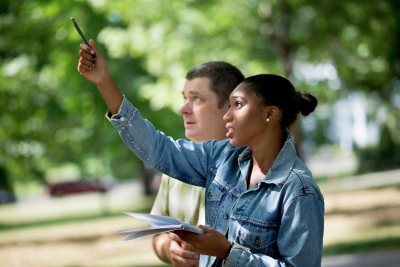
Research is also central to the undergraduate experience at Bates. We recommend that Bates maintain the thesis/capstone experience as a requirement for every student. It is the primary vehicle for student scholarship and an integrative and critical component of students’ four-year arc of development. The collaboration between students and faculty on a thesis or capstone project is a culminating experience and a distinguishing characteristic of a Bates education, and can be an excellent foundation for the kinds of professional independence and initiative that will be demanded of our graduates throughout their lives.
Beyond the thesis/capstone experience, we recommend that Bates expand research opportunities for students in all departments and programs. Funds should be raised to endow summer research fellowships, faculty- student research collaborations, and support for research and professional conference travel. We also recommend pursuing funding for a speaker series that would bring outside experts and scholars to Bates to enhance the intellectual and scholarly conversations of the campus community.
2.5 Strengthen our institutional commitment to community-engaged learning, research, and practice.
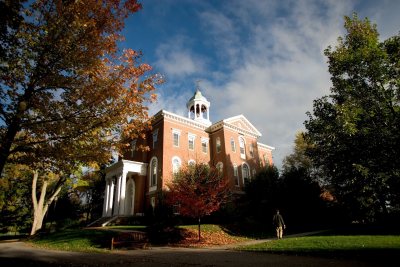 Under the leadership of former president Donald W. Harward, Bates achieved national prominence as an innovative center of community-engaged learning, research, and practice. The Harward Center for Community Partnerships now stands as a hub of this activity at Bates and is recognized as a national leader. The commitment to community-engaged work enables important learning, research, and leadership experiences for students; supports publicly engaged pedagogy and scholarship by faculty; and creates and facilitates mutually beneficial relationships in Lewiston and Maine. A community engagement ethos is now a distinctive feature of Bates and it should maintain its prominence for prospective students, the Bates community, the communities in which we live, and granting institutions.
Under the leadership of former president Donald W. Harward, Bates achieved national prominence as an innovative center of community-engaged learning, research, and practice. The Harward Center for Community Partnerships now stands as a hub of this activity at Bates and is recognized as a national leader. The commitment to community-engaged work enables important learning, research, and leadership experiences for students; supports publicly engaged pedagogy and scholarship by faculty; and creates and facilitates mutually beneficial relationships in Lewiston and Maine. A community engagement ethos is now a distinctive feature of Bates and it should maintain its prominence for prospective students, the Bates community, the communities in which we live, and granting institutions.
Community-engaged learning is a powerful dimension of our students’ educational experience. We recommend that Bates reinforce its commitment to such learning in three ways. First, we call for the continued development of curricula and courses that have thoughtful community-engaged learning and research components. Second, we call on the general education review process to consider the possibility of more systematic integration of community engagement in the overall educational experience of Bates students. Third, we recommend that as we explore how to make academic records more legible to audiences beyond Bates and as we consider the possibility of adopting experiential transcripts, we should take advantage of opportunities to make students’ community-engaged work more visible.
2.6 Support the arts as a core element of the liberal arts experience.
Creativity and artistic expression play a major role in academic fields, student organizations, and programs across the Bates campus. The arts are vitally linked to the curriculum in humanities, social sciences, and the natural sciences. Whether it is the analysis of artistic works in English or art history classes, print making in studio art classes, or design innovations in physics classes, Bates students and faculty apply artistic imagination to their work on a daily basis. From our Museum of Art to our many student arts groups to our Theater and Dance Department and Dance Festival productions, the Literary Arts Live reading series, Olin Concert Series, the Music Department, and beyond, Bates organizations present a rich spectrum of exhibitions, practice, and performance that provide important developmental opportunities for our students and unifying moments for the campus community.
The Arts Collaborative, created in 2010 and voted as a standing committee in 2013, has made important progress in raising the visibility of the arts at Bates through a unified arts calendar and greater attention to how the arts are portrayed in a variety of Bates publications. Building on these efforts, we recommend that Bates continue to invest in the arts in tangible ways. First, we propose that Bates raise money to support visiting artists who will integrate their work into the life of the college while they are on campus. Second, as part of campus facilities planning, we propose the college consider the need for arts spaces, including maker space, rehearsal and performance space, exhibitions and collections space, and appropriate storage space. Finally, the Arts Collaborative should continue to foreground the role of the arts as a core element of the liberal arts experience.
2.7 Engage critically with technology as a force reshaping intellectual work and social relations.
Our small residential college has engaged transformative technological change since its founding, from the industrial mechanization that enabled the success of Benjamin Bates’ textile factories to the diffusion of the personal automobile, which altered both the physical landscape of campus and the social proximity of students, faculty, and staff. Bates continually shapes—and is shaped by—broader technological forces.
Instead of taking the “asteroid” approach to discussions of technological change—that is, responding or reacting to the impact of technology on the liberal arts college—we engage emerging technologies as works-in-progress, tools that we adapt and refine in accordance with our distinctive needs and priorities. We debate and determine how we might best deploy them toward the fulfillment of our abiding mission of inclusive, emancipatory education. As students in the 1880’s argued for new postal boxes in the name of “the progressive spirit of our institution,” so, too, students today engage with technological opportunities—and inequities—as a component of their growth as integrative, critical thinkers.
To carry forward this tradition of critical and creative engagement with technological change, we propose that our curriculum—in and beyond the new program and major in Digital and Computational Studies—expose students to questions of how these artifacts and systems reflect and reinforce social choices. Beyond the formal curriculum, we recommend that students, faculty, and staff at the college engage with questions of how to adapt, as appropriate, norms of interaction and communication given that technology and virtual networks are woven into the fabric of social relations even on a residential campus. As a leading liberal arts college, Bates should not aspire simply to turn out competent programmers, data engineers, and digital architects, but rather innovators, across fields, equipped to examine and amend the silent presuppositions of an evolving digital world.
2.8 Optimize Short Term as a distinguishing feature of a Bates education.
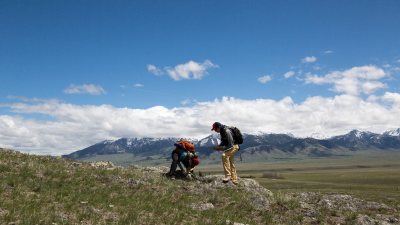 We recommend that Bates work to optimize Short Term as an academically valuable, experimental, and distinctive part of the Bates experience. During Short Term, faculty and students have fewer scheduling conflicts and are free to experiment, explore, and pursue enriching experiences in ways they are not at other times in the calendar. We propose that Bates explore ways of increasing opportunities and financial support for programs such as field work, faculty-led travel and study, course development and redesign, practitioner-taught courses, and skill development programming that promote distinctive and high-quality experiences in Short Term.
We recommend that Bates work to optimize Short Term as an academically valuable, experimental, and distinctive part of the Bates experience. During Short Term, faculty and students have fewer scheduling conflicts and are free to experiment, explore, and pursue enriching experiences in ways they are not at other times in the calendar. We propose that Bates explore ways of increasing opportunities and financial support for programs such as field work, faculty-led travel and study, course development and redesign, practitioner-taught courses, and skill development programming that promote distinctive and high-quality experiences in Short Term.
2.9 Integrate global education off-campus with campus, curricular, and community work.
Bates is a recognized leader among peer institutions both in rates of off-campus study participation and in a focus on longer, more immersive experiences abroad. Approximately two-thirds of Bates students study off-campus, the vast majority outside the U.S., for either a semester or an academic year. This high participation reflects an institutional commitment to both promoting the intrinsic value of substantive engagement with cultures other than our own and meeting the student demand for global opportunities. The breadth of rigorous programs available to Bates students is extensive and students are well-supported with individualized advising as they pursue global study plans.
At this time, Bates has an opportunity to more fully integrate off-campus study with the learning experience of students throughout their time at Bates and in collaboration with the teaching and research focus of faculty. We recommend that Bates optimize the off-campus experience by creating more links to the curriculum and campus life both before and after students go abroad by, for instance, further connecting off-campus study with study in the major, intentionally engaging returning students within departments and programs, developing opportunities for reflection and self-awareness for students during and after study abroad, and more closely connecting global learning with thesis and capstone projects and the ethical field research and critical inquiry skills needed to accomplish both. We recommend that the college give more careful attention to the intellectual and social dimensions of returning students, including a focus on meaningful ways to extend the intellectual enthusiasm and experiential learning potential of off-campus study to collaborative engagements with home and local communities, including those at Bates.
CHARTING NEW DIRECTIONS
2.10 Develop a model of general education that achieves our educational goals.
We recommend that Bates examine its current general education program to assess its success in fulfilling our mission, achieving our collective educational aims, and enabling students to gain the content knowledge and different ways of knowing that characterize our varied disciplines of study including the humanities, the natural sciences, social sciences, and interdisciplinary studies. While our requirements are intended to foster integrative learning and ensure that students gain essential knowledge and skills, they strike many as imbalanced, and there is increasing concern from both faculty and students that the current structure of general education operates in an overly mechanistic way that inhibits the student agency, integrative learning, and creativity it aspires to provide.
There is also ongoing concern that the current general education requirements do not adequately take account of the importance of the humanities in our curriculum. Given the fundamental commitment of the liberal arts to promoting humanistic inquiry and encouraging students to make connections among specialized fields of knowledge, any proposals for change to the current structure or requirements of general education should be evaluated in light of their impact on the study of the humanities at Bates.
There is also concern among students and faculty that the current general education model does not live up to Bates’ historic commitment that students formally engage with a broad and diverse world. The assessment of general education currently being carried out under the auspices of the Academic Affairs Council should proceed as quickly as possible in the 2016–17 academic year to arrive at a view of the effectiveness of the current program and design new or alternative structures as necessary to promote an educational experience consistent with our mission, with the aims of a liberal arts education, and with the goal of fostering intellectual agency among our students.
The examination of general education should also encompass attention to both breadth and depth in our students’ educational experience. To that end, the review should take into account whether students are exposed to courses in the humanities and the arts, the social sciences, the sciences, and interdisciplinary approaches. Additionally, an important goal of this endeavor is to make our educational experience legible outside of Bates. Consideration of how academic records and experiential transcripts are constructed should be part of this work.
2.11 Fortify the distinctive elements of science education at Bates.
We recommend that Bates pull together the efforts underway in research, faculty-student engagement, and inclusiveness to create a best-in-class undergraduate education in the sciences.
Science faculty at Bates successfully compete for federally funded grants in a range of fields, and they systematically involve students in the research agendas supported by these grants. Because we require that each student complete a thesis or capstone project, many students get deeply involved in this work and some emerge as co-authors on peer-reviewed publications.
In recent years, we have funded, through the Catalyst Fund, efforts to improve science pedagogy at Bates by emphasizing inquiry- based teaching and learning and more-active approaches to classroom and lab experiences. We have also secured funding for students who conduct faculty-supervised research over the summer. Recently, a group of faculty submitted a grant proposal to support high-financial-need students majoring in STEM fields, from the first year through the senior thesis. Another grant proposal under development focuses on fundamental redesigns of science courses and pedagogy.
One goal of these efforts is to expose our students to first-class experiences in the sciences—including working directly with tenured and tenure-track members of the faculty—from the moment they arrive at Bates. An equally important goal is to support all students, particularly those from underrepresented groups, for success in STEM fields. Our mission and history create an imperative for equity in education and an accompanying obligation to support the intellectual aspirations of every student. Accordingly, we should set the goal of becoming a national leader in preparing students from all backgrounds for success in the sciences while they are at Bates and as they pursue postgraduate opportunities. Central to this endeavor is a faculty well-steeped in the practice of inclusive pedagogy and committed to curricular diversity in course content—aims that are as salient in the sciences as in other disciplines.
We recommend that Bates develop a comprehensive, multi-year program in the STEM fields designed particularly to support students from underrepresented groups and to create an inclusive climate and culture in STEM. This program should include a commitment by faculty to develop and integrate methods, tools, and approaches that afford all students from all backgrounds opportunities to excel in the sciences.
2.12 Build new science facilities to support our ambitions in science education.
The natural sciences at Bates need appropriate teaching and research facilities in order to support excellence in teaching, learning, and research; facilitate collaboration; improve efficiencies; increase capacity; and allow flexibility. Departments are currently housed in multiple buildings across campus, resulting in barriers to cross-departmental cooperation and resource redundancies, even as STEM faculty emphasize the multidisciplinary and constantly evolving nature of modern science.
We recommend that the college create an integrated system of science facilities that provides appropriate spaces for instructional and research activities, leveraging both existing and new structures, and that the proposed science facilities project be prioritized in the coming fundraising campaign. As a planning committee considers the design and programming of the new science facilities, we recommend that they incorporate in their thinking universal design principles for accessibility; the possibility of including movable walls or lab benches for modular, collaborative work-spaces; the potential of state-of-the-art video conferencing capabilities for global collaboration; reserving space for scholars in science education, philosophy of science, or other inter-sectional fields; and including exhibition space.
2.13 Implement the new program and major in Digital and Computational Studies.
We recommend that Bates move expeditiously to implement the program and major in Digital and Computational Studies and to engage students and faculty in the critical examination of technology in all aspects of our lives.
In May 2015, the Bates faculty voted to establish a formal academic program in Digital and Computational Studies (DCS), with the goal of establishing a major by 2018. In February 2016, the college announced that it had raised pledges totaling $10 million in endowment to support the three faculty lines necessary to mount the program and major in DCS and provide program support. The speed with which the college moved to design the DCS program and secure funding represents a recognition that computers and data play an increasing role in advancing knowledge within and across disciplines and that more occupations than ever before demand computational thinking. Furthermore, Bates is distinctly well-positioned to become a national leader in promoting inclusive practices in DCS, beginning with initial faculty hiring for the program and including developing a program, climate, and culture designed to include people who are historically underrepresented in the field, including women and members of other groups.
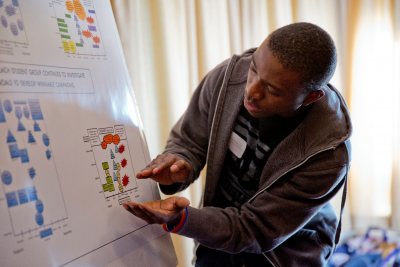 Crucial to the conceptualization of the new DCS program is the specific liberal arts context in which it will be embedded. In one sense, DCS can be thought of as offering access to a new and powerful language for the classic goals of the liberal arts—careful reasoning, creative problem solving, and clear expression. As such, it becomes a prime site not only for equipping our students with new tools and knowledge, but also for encouraging them to engage critically with the processes of computation, digitization, and automation owing through every aspect of contemporary life. Facilitating command of crucial tools, platforms, and infrastructures, our curriculum—in and beyond the major in DCS—will enable our students to understand how these systems reflect and reinforce social choices. Thus, in addition to producing competent programmers, data engineers, and digital architects, Bates will also produce innovators across fields equipped to examine and amend the silent presuppositions of an evolving digital world. We recommend that Bates craft a DCS curriculum based on a deep understanding of the inextricability of social values and technical design, one that is distinctive among computer science programs in that it encourages students to apply integrative liberal arts sensibilities to their technical training.
Crucial to the conceptualization of the new DCS program is the specific liberal arts context in which it will be embedded. In one sense, DCS can be thought of as offering access to a new and powerful language for the classic goals of the liberal arts—careful reasoning, creative problem solving, and clear expression. As such, it becomes a prime site not only for equipping our students with new tools and knowledge, but also for encouraging them to engage critically with the processes of computation, digitization, and automation owing through every aspect of contemporary life. Facilitating command of crucial tools, platforms, and infrastructures, our curriculum—in and beyond the major in DCS—will enable our students to understand how these systems reflect and reinforce social choices. Thus, in addition to producing competent programmers, data engineers, and digital architects, Bates will also produce innovators across fields equipped to examine and amend the silent presuppositions of an evolving digital world. We recommend that Bates craft a DCS curriculum based on a deep understanding of the inextricability of social values and technical design, one that is distinctive among computer science programs in that it encourages students to apply integrative liberal arts sensibilities to their technical training.
2.14 Create a multidisciplinary institute focused on questions or topics of societal importance.
We propose that the college establish an institute designed to function as an incubator of ideas, research, pedagogy, and programming pertaining to specific questions or topics of societal importance. A small group of faculty (three or four) and, potentially, scholars from beyond Bates, will be invited to propose a problem of study—for instance, climate change, migration, or income inequality—that will be tackled from a multidisciplinary perspective over a two- to three-year period. Students and interested staff will participate through thesis projects, coursework, collaborative research projects, and co-curricular initiatives. Additionally, the topic could inform the Common Read, First-Year Seminars, and like- themed courses. Near the end of each multi- year period, a conference or showcase might be convened to present work generated in relation to the chosen question or topic. As one institute cycle comes to a close, a successor group of faculty would propose a new topic or question, and the work would begin again. The funding required for this platform would be relatively modest, and we recommend that the concept of the institute be included in the upcoming fundraising campaign.
Beginning as early as Short Term 2017, interested faculty could be invited to collaborate with students on a “course design” aimed at developing an initial concept for how the institute will operate and identifying the first topic to be explored.This could be done via a course re-design or collaborative workshop.
Priority 3. Educating the Whole Person
Educate the whole person by supporting the integration of intellectual and personal growth across a student’s four years at Bates.
A critical component of educating the whole person is the process through which students become aware of their interests, community, and purpose in the world. Bates fosters a residential campus culture that encourages agency, exploration, and reflection for all students and supports the integration of intellectual and personal growth throughout their four years at Bates.
BUILDING ON STRENGTHS
3.1 Create a more coherent and intentional approach to the student experience that promotes reflection among students and greater self-awareness of their trajectory through Bates.
The process of inspiring self-awareness and agency in our students begins before students come onto campus for their first year, and continues through their four years at Bates and into adulthood. Seldom the product of a single transformative experience, this process is gradual, incremental, cumulative, and highly individual. It takes shape in different ways and at different paces depending on how students choose to shape their educational experience both inside and outside the classroom.
We promote opportunities for reflection and leadership through programming as varied as AESOP, Purposeful Work, community-engaged learning, global off-campus study, athletics, the arts, peer leadership opportunities, the Multifaith Chaplaincy, the Martin Luther King Jr. Day celebrations, and faculty mentorship. We recommend that Bates more intentionally leverage learning and best practices across these and other programs in order to improve the effectiveness of the individual experiences and make the cumulative impact of a range of experiences more coherent and powerful for individual students. By creating and supporting opportunities for reflection, students are better able to recognize and focus on their personal growth achieved through a variety of experiences. In addition to thoughtful advising and guidance from faculty and staff, one mechanism that might promote greater integration of a range of experiences is a co-curricular or experiential transcript. Such transcripts would allow Bates students to present a record of their participation in the various experiential learning opportunities that are fundamental to student learning and development.
3.2 Strengthen institutional support for athletics for students, faculty, and staff at all levels of participation and ensure that this important area of the college has an inclusive climate and is welcoming to all.
Athletics are an important dimension of life at Bates. They play a strategic role in attracting students through Bates’ membership in the New England Small College Athletic Conference (NESCAC); in developing leadership, collaboration, and a strong work ethic in students who participate on teams, whether varsity, club, or intramural; in promoting the health and wellness of the entire college community through access to programming and facilities that support fitness; and in generating engagement with the college by alumni, parents, and the broader public. Among our varsity teams, some have enjoyed sustained success over decades, others have had considerable success in more recent years, and others have had difficulty achieving and sustaining a competitive record. Of course, wins and losses are not the only measure of a strong experience in athletics, and Bates is proud to be a leader in establishing an inclusive environment for athletics, and developing leadership and service programs for athletes that generate benefits for both athletes and the broader college community.
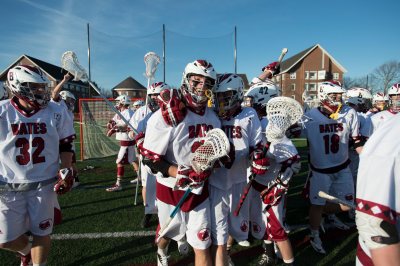 This past academic year (2015–16), the Department of Athletics engaged in a comprehensive review that involved a self-study, a study by an internal review team of faculty and staff, and an external study conducted by athletic directors from three other liberal arts colleges. While both the internal and external reviewers found much to praise in Bates’ athletics, they each called for a stronger organizational model for the department, more transparent and reliable funding and staffing models to support coaches and teams, a more structured and equitable approach to fundraising that takes fundraising pressure off individual coaches, and a systematic review of athletics facilities and prioritization of facilities needs.
This past academic year (2015–16), the Department of Athletics engaged in a comprehensive review that involved a self-study, a study by an internal review team of faculty and staff, and an external study conducted by athletic directors from three other liberal arts colleges. While both the internal and external reviewers found much to praise in Bates’ athletics, they each called for a stronger organizational model for the department, more transparent and reliable funding and staffing models to support coaches and teams, a more structured and equitable approach to fundraising that takes fundraising pressure off individual coaches, and a systematic review of athletics facilities and prioritization of facilities needs.
Guided by these recommendations, the college will strengthen the organization and staffing of the athletics department and, in the upcoming campaign, we will include as a priority increasing endowment support for athletics salary and operating budgets. Additionally, we will undertake an assessment of existing athletics facilities and identify the most immediate and achievable priorities for new construction or renovations. This prioritization will be used to guide athletics facilities fundraising for the upcoming campaign.
3.3 Reinforce our commitment to the natural world and environmental sustainability in the operations of the institution and in the promotion of environmentally sound practices of members of our community.
Bates asks its students, faculty, and staff to consider their place in the natural world and take seriously their responsibilities as its stewards. A Bates education should encompass consideration of environmental sustainability, stewardship of the natural world, and sense of place. As an institution, Bates should model responsible stewardship in its policies and decisions regarding facilities, infrastructure, and technology. Current efforts, such as the newly revitalized Committee on Environmental Responsibility, assessment of the college’s sustainability goals, and exploration of alternative energy sources, will be important ongoing priorities. Initiatives like the EcoRep program will also be important to student involvement in the campus culture of sustainability. We recommend that Bates think and act deliberately with regard to environmental sustainability and consider, from the individual to the institutional level, our own environmental impact. This work could include new communication strategies, campus engagement initiatives, and consolidation of student environmental groups.
CHARTING NEW DIRECTIONS
3.4 Promote Purposeful Work as a distinguishing element of the Bates experience and seek ongoing funding for the program.
Preparing students for lives of meaningful work has always been a powerful dimension of the liberal arts education we provide at Bates. Today, however, this goal needs to be pursued with greater intentionality and effectiveness. Accordingly, and with support from the Catalyst Fund, we have spent the past three years designing a mission-based, developmental, and pragmatic approach to helping students think about work—both while they are in college and as they graduate. Our efforts combine a developmental approach to helping students reflect on their interests and goals with a set of high-quality work experiences in a broad range of fields that allows them to build skills and pressure-test their interests. Finally, through the Purposeful Work initiative and through the Bates Career Development Center, we work actively to connect students with outside partners as they seek to develop postgraduate opportunities.
Specific Purposeful Work programs have included curricular infusion, practitioner-taught courses in Short Term, internships with core employers, and exposure to a range of speakers and workshops through “Purposeful Work Unplugged” and other series. These programs have been assessed from the outset, and the results have been overwhelmingly positive. To date, the Purposeful Work program has been funded through spend-down money raised under the auspices of the Catalyst Fund, which will expire by 2020.
We propose that Bates build on the Purposeful Work initiative to establish itself as a leader in re-framing the national conversation about the relevance—indeed, the particular effectiveness—of the liberal arts to preparing students for life, work, and social contribution. To achieve this goal, Bates should raise endowment funding for the Purposeful Work initiative, actively foster the links between this program and the curriculum, and work to promote visibility for Bates’ distinctive approach in targeted media outlets.
3.5 Provide students with resources to maintain the health and wellness necessary to achieve academic and personal success during their time at Bates and beyond, paying special attention to the differentiated needs of students with disabilities and from other marginalized groups.
We propose that Bates strengthen its framework of medical services, including mental health services, to better serve all students. Bates should create appropriate staffing structures and develop a set of services and standards that reflect best practices in the medical field, including those services to support students with diverse identities and mental health needs. Additionally, we propose that Bates establish a peer-based four-year co- curriculum for health and wellness to support informed decision-making by students and reduce harmful behaviors. Bates students are thoughtful, creative, and community-oriented, and could be better integrated into the work of building campus community and educating our community members about their own accountability for making healthy choices. Finally, we should leverage existing student support portals to further strengthen systems and structures to share relevant information among faculty, staff, and coaches about students of concern so that, in turn, we are able to provide thoughtful and timely guidance and support to students.
3.6 Optimize facilities that support student services, co-curricular endeavors, and social life.
We recommend that Bates invigorate the campus life core of the residential experience with a lively campus center facility, either by re-imagining Chase Hall or by designing and building a new facility. Such a facility would potentially provide spaces for students to gather, flexible spaces for programming and student organization meetings, studio and maker space, and the offices and centers that enable students to explore the range of interests they bring to and discover over the course of their Bates career.
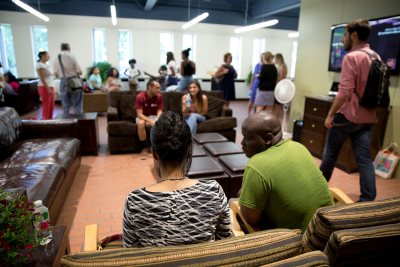
Student-centered offices and services should be located in the campus center, making it a hub of activity during the day, when student organizations tend not to be active, as well as in the evening, when student-driven programs thrive. Offices such as the Office of Intercultural Education, the Office of Campus Life, Purposeful Work, the Bates Career Development Center, the Multifaith Chaplaincy, and the Harward Center for Community Partnerships would all make reasonable candidates for space in a campus center. The space should be designed to invite the campus community, college visitors, and the public in by locating within it a lively array of services.
Priority 4. Strengthening Financial Sustainability
Achieve a stronger and more sustainable financial base commensurate with our ambitions.
For Bates, achieving a more robust and sustainable organizational and financial model is a key strategic imperative. Our financial model must ensure a diverse portfolio of students who can afford to attend and adequate capacity to support the education we aspire to provide, with appropriate staff and facilities. It must also include an elevated culture of philanthropy that provides a meaningful revenue stream year after year.
BUILDING ON STRENGTHS
4.1 Maximize the financial sustainability and revenue orientation of the college.
Bates needs to explore and actively pursue promising resource growth opportunities. These will include a single-fee growth strategy that balances restraint in pricing with the ability to provide a high-quality education while continuing to attract a diverse range of students. We also need to achieve fundraising and investment performance that increases Bates’ endowment and shifts the balance of educational costs away from tuition. Bates also has a resource in its facilities that is not fully utilized; we should make the most of the general facility, minimizing sparse usage—e.g., summer usage—and finding ways to introduce new programs that do not create competition for existing programs.
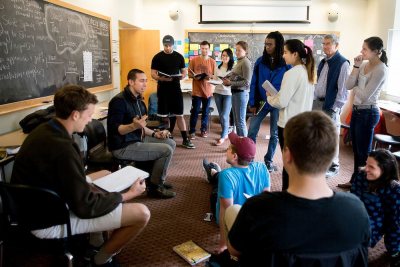
The single most effective way to improve the financial sustainability of the college will be a sustained increase in the endowment. This effort is a long—multi-decade—process, with an important opportunity in the coming comprehensive fundraising campaign to make strides in addressing the college’s financial position. To best address Bates’ sustainability, we propose that the campaign include as a core focus raising money for endowment to support existing activities, while taking care to ensure that any grants being pursued and any restricted gifts received are for mission-critical projects and resources.
4.2 Maintain consistent and appropriate investment to address deferred maintenance needs.
Bates’ physical plant is one of our key resources and assets, and it must be continually maintained to prevent atrophy and degradation. Responsible stewardship of our physical plant is not only vital to delivering on our mission today, it is a crucial inter-generational commitment to ensuring that tomorrow’s students aren’t paying for the facilities costs that we are deferring in the present. We also know that to compete effectively for new students, faculty, and staff, and to facilitate their work and experiences on our campus, we need to ensure that academic, residential, athletic, and administrative facilities are suitable for their purposes.
Deferred maintenance, left too long, can create facilities emergencies that upend multi-year strategies for capital improvements Bates might have carefully designed and well-articulated plans for renovations and new construction over the long term—for instance, those recommended elsewhere in this plan—but a systemic failure in an existing building will require the diversion of attention and funds to address that emergency need. We recommend that Bates continue to prioritize investment in its known deferred maintenance needs.
4.3 Prioritize investments in technology infrastructure.
Bates’ technical infrastructure is both visible and invisible, but it is universally critical to the functionality of our campus and the quality of the educational experience we offer. We recommend that Bates invest significantly in technical infrastructure—computer clusters, media labs, telephone systems, wireless networks, application servers, backup services, etc.—that Information and Library Services can use to systematically address its needs.
As technology advances and faculty and students seek opportunities to conduct computationally intensive work, for example, we will require additional equipment, elastic cloud services, and new staff competencies to handle this sophisticated research and learning. Demand for these types of high-performance computing resources will certainly grow, and Bates must be ready to accommodate that growth. An ILS fund would allow us to move nimbly to make improvements, accommodate increasingly computationally sophisticated forms of teaching and research, address unexpected faculty requests and building renovations, and replace faulty equipment.
4.4 Rigorously evaluate new proposals that entail significant expenditure to ensure that they are aligned with key college priorities.
A reliable and well-considered process for evaluating new proposals for significant expenditure—as well as existing efforts—will be critical to an intentional allocation of resources at Bates Proposals that merit scrutiny will:
- Be aligned with the college’s mission.
- Answer a key college priority or aspirational goal, or address a key college risk.
- Call on existing staff and leadership to implement the project in an effective and intentional manner.
- Survive as a priority if Bates used zero-based budgeting.
Once these qualifications are met, we propose that Bates consider how proposals measure on dimensions of impact, risk, and cost as represented by these questions:
- What is the impact of this proposal, and on whom?
- What are the aspirational goals the proposal advances?
- Are we fulfilling our goals in an intentional way?
- To what extent does this proposal address organizational risk?
- What is the long-term outcome of the status quo?
- If other proposals are advanced and this one is not, what are the implications?
- What is the cost of the proposal, comprehensively considered?
4.5 Explore institutional collaborations.
We recommend that Bates explore ways to enhance the education we provide by finding ways to leverage potential partners who share geographic proximity and/or mission-critical goals. Exploring these potential relationships with other institutions and organizations is an important dimension for maximizing our resources and opportunities. Collaborations should begin from a position of strength, consider locational hurdles creatively, and be resourcefully, but realistically, investigated and implemented.
Bates’ commitment to seeking out and taking advantage of opportunities for collaboration should be codified such that any proposal to add a new program on campus systematically considers possible areas for collaboration or consolidation, as does any regular review of existing campus efforts.
4.6 Leverage resources efficiently and maximize the flexibility of physical resources.
We propose that Bates work to maximize the use of its physical facilities. As signaled in Action 4.1, we need to identify which resources are underutilized and when, then determine whether there are ways to minimize sparse usage and introduce programs that do not create competition for existing programs. For example, if Bates has capacity within dormitory facilities, a camp or conference that uses both those beds and unused spaces elsewhere on campus would be an excellent partner for Bates. We might also explore opportunities for efficiency within course scheduling, events management, and classroom management. We must be cognizant of the value of our resources, identifying those opportunities that are both consistent with Bates’ mission and possessing the capacity to generate resources for core operations of the college.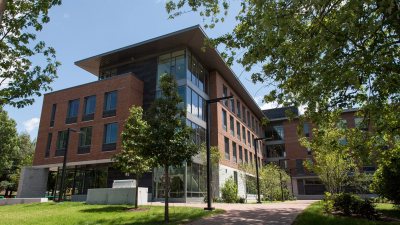
From Plan to Action
As noted above, because we operate through a system of shared governance, with faculty, staff, students, trustees, and alumni playing a role in decision-making, this framework of priorities is meant to be flexible and dynamic, evolving over time, and informed by appropriate governance processes. Within each of the categories, responsibility for progress on specific issues or action items falls under the purview of different members of the senior staff, standing faculty committees that are part of existing governance structures, or future ad hoc committees that will be appointed as needs arise. These individuals and committees will develop detailed plans and timetables for sequencing the activities called for in the plan.
Each action from the plan appears (in abbreviated form) below, organized in categories reflecting the type of action called for. The numbers in parentheses indicate the priority and action from which each item was drawn—e.g., (2.5) refers to Priority 2, Action 5.
| INSTITUTIONAL PRIORITY / FUNDRAISING FEASIBILITY TO BE ASSESSED |
|---|
|
| WORK IN PROGRESS / FUNDRAISING IN SOME AREAS REQUIRED |
|
| LONGER-TERM ISSUES REQUIRING FURTHER DISCUSSION AND DEVELOPMENT |
|
Appendix A
Process
The planning process began during the 2014– 15 academic year as a series of conversations with Bates students, faculty, staff, trustees, and alumni representatives. These conversations established broad agreement that institutional planning needed to be forward-looking and aspirational, yet grounded firmly in Bates’ values, as they were established at our founding and more recently reaffirmed in our mission statement of 2010.
In March 2015, Bates announced the four teams that would carry out the central work of the institutional planning process. These teams comprised faculty, staff, and students, and were chosen through a combination of election and appointment. The teams were:
- Intellectual Life at Bates
- Educating the Whole Person
- Facilities, Infrastructure, and Technology
- Resources
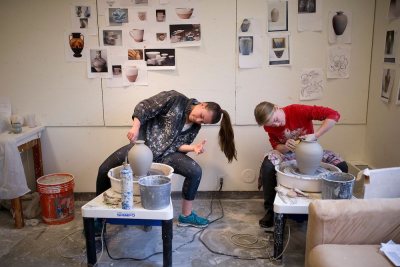 The work of the four teams included community consultation at key points throughout the process, and was supported by a data and technology team. A steering committee oversaw the process as a whole and was made up of the chairs of the individual teams, members of Bates’ senior staff with responsibilities in the areas under consideration, and several faculty members appointed at large. The steering committee was chaired by the President and the Dean of the Faculty. In all, 79 members of the Bates community served in formal roles in the planning process.
The work of the four teams included community consultation at key points throughout the process, and was supported by a data and technology team. A steering committee oversaw the process as a whole and was made up of the chairs of the individual teams, members of Bates’ senior staff with responsibilities in the areas under consideration, and several faculty members appointed at large. The steering committee was chaired by the President and the Dean of the Faculty. In all, 79 members of the Bates community served in formal roles in the planning process.
The teams spent Short Term 2015 developing the questions that would guide their discussions and formulating data requests. Over the summer, data were compiled for each team. During the fall semester of 2015, the individual teams explored the issues relevant to their respective guiding questions; considered data, as available, to answer the questions; and began the process of crafting recommendations.
In January 2016, the steering committee began the process of integrating the recommendations developed by the individual teams into a unified framework. We articulated a set of priorities and placed them in an intentional order, then refined both the order and the priorities themselves. By necessity, every recommendation from every team report does not appear, verbatim, in the final list of priorities. Yet team members will recognize the core ideas articulated in each of the team reports in this comprehensive plan.
In addition, a trustee liaison group was convened to provide external perspective, strategic input, and fiduciary oversight to the steering committee on behalf of the Board of Trustees. Beginning in the winter of 2016, and extending through the beginning of the next academic year, the steering committee has been engaged in an intensive process of outreach with students, faculty, staff, and alumni to share draft text and recommendations and invite input In the fall of 2016, this institutional planning report will be presented to the full faculty and the Board of Trustees for endorsement.
Constituting the Teams
The teams were composed based on the particular needs of the team, individuals’ expressed interests, and other considerations. They were populated through broad outreach and an invitation for individuals—students, faculty, and staff —to express an interest in participating. In all, 79 faculty, students, and staff participated in the process.
- Faculty were chosen through an election process, organized by division. Teams were composed based on the highest voting totals in each division with additional appointments made for purposes of achieving balance of various sorts. All faculty participants in the planning process were drawn from faculty who stood for election.
- Interested staff were appointed to teams in consultation with their supervisors and managers.
- Students submitted statements of interest to the Committee on Committees (CoC) and were interviewed and appointed by the CoC with additional appointments made for purposes of achieving balance of various sorts.
Engagement with Bates Community
| Topic | Faculty* | Staff ** | Students*** | Trustees/ Alumni Council/BFEC | |
| Fall 2014 | Broad engagement on questions of both substance and process | 8 sessions | 4 sessions | 2 sessions | 1 sessions |
| December 2015 – February 2016 | Discussion of “Values and Aspirations” document | 6 sessions | 4 sessions | N/A | 2 sessions |
| March – April 2016 | Discussion of draft report | 8 sessions | 4 sessions | 6 sessions | 2 sessions |
| September 2016 | Discussion of draft report | 4 sessions | 2 sessions | 1 sessions | N/A |
* Including discussions with AAC, EPC, CCC, and department and program chairs
** Including President’s Council meetings
*** Including athletes, OIE Fellows, Multifaith Fellows, Stringfellow Leaders, SPARQ Peers, Bonner Leaders, and members of Mosaic Student Organizations, Student Government and Chase Hall Committee, JARCs
Summer 2016
Open for comment to all alumni from July 25 through August 8.
Fall 2016
Institutional Plan presented to the Bates Faculty and the Board of Trustees for endorsement.
Appendix B
Team Rosters
INTELLECTUAL LIFE
Chair
Georgia Nigro, Professor of Psychology
Staff
Matt Duvall, Senior Director of Strategy and Analysis, Dean of the Faculty’s Office
Team Members—Faculty
Senem Aslan, Assistant Professor of Politics
Matt Auer (Ex Officio), Vice President for Academic Affairs and Dean of the Faculty
Jon Cavallero, Assistant Professor of Rhetoric
Jane Costlow, Clark A. Griffith Professor of Environmental Studies
Matt Côté, Associate Professor of Chemistry; Chair, Division of the Natural Sciences David Cummiskey, Professor of Philosophy
Alex Dauge-Roth, Associate Professor of French and Francophone Studies
Nancy Koven, Associate Professor of Psychology
Team Members—Staff
Ellen Alcorn, Director of Bonner Leader Program, Assistant Director of Community-Engaged Learning
Christina Bell, Humanities Librarian, Information & Library Services
Mary Meserve, Registrar
Dan Mills, Director of the Museum of Art and Lecturer in the Humanities
Team Members—Students
Jeremy Glover ’17
Cira Mollings Puentes ’16
Erica (Jaqui) Veazey ’16
EDUCATING THE WHOLE PERSON
Chair
Stephen Engel, Associate Professor and Chair of Politics
Staff
Genevieve Leslie, Director of Annual Giving, Advancement
Team Members—Faculty
Rachel Boggia, Assistant Professor of Dance
Dyk Eusden, Professor of Geology
Rebecca Fraser-Thill, Lecturer in Psychology, Director of Program Design for Purposeful Work
Margaret Imber, Associate Professor of Classical and Medieval Studies
Darby Ray, Director of the Harward Center for Community Partnerships and Donald W. and Ann M. Harward Professor of Civic Engagement
Kirk Read (ex Officio), Professor of French and Francophone Studies; Associate Dean of the Faculty
Mike Retelle, Professor of Geology
Susan Stark, Associate Professor of Philosophy
Team Members—Staff
Julisa De Los Santos, Assistant Dean, Office of Intercultural Education
Gwen Lexow, Title IX Officer, President’s Office
David McDonough, Director, Career Development Center
Josh McIntosh (Ex Officio), Vice President for Student Affairs and Dean of Students
Team Members—Students
Kristen Kelliher ’16
Deshun Peoples ’17
Sarah Stanley ’16
Shanina van Gent ’18
FACILITIES, INFRASTRUCTURE, AND TECHNOLOGY
Chair
Nathan Lundblad, Associate Professor of Physics
Staff
Scott Tiner, Assistant Director for Client Services, Information & Library Services
Team Members—Faculty
Aslaug Asgeirsdottir, Associate Professor of Politics
Ryan Bavis, Professor of Biology
Dennis Browne, Associate Professor of Russian
Carol Dilley, Professor of Dance
Kathy Low (Ex Officio), Professor of Psychology; Associate Dean of the Faculty
Adriana Salerno, Associate Professor of Mathematics
Nate Tefft, Assistant Professor of Economics
Team Members—Staff
Kevin McHugh, Director of Physical Education/Athletics
Camille Parrish, Lecturer, Learning Associate, Environmental Studies
Andrew White, Director, Academic and Client Services, Information & Library Services
Pamela Wichroski, Director of Capital Planning and Construction, Facility Services
Team Members—Students
Nikolay Stambolski ’17
Molly Chisholm ’17
RESOURCES
Chair
Geoff Swift, Vice President for Finance and Administration and Treasurer
Staff
Jeremy Cluchey, Director of Creative Design, Bates Communications Office
Team Members—Faculty
John Baughman, Associate Professor of Politics
Raluca Cernahoschi, Assistant Professor of German
Hong Lin, Professor of Physics
Michael Murray, Charles Franklin Phillips Professor of Economics
Mary Rice-DeFosse, Professor of French and Francophone Studies
Paul Shea, Assistant Professor of Economics
Team Members—Staff
Doug Ginevan, Assistant Vice President for Financial Planning and Analysis
Wendy Glass, Director of Student Financial Services
Randy Shaw, Associate Vice President for College Advancement
Jason Scheideman, Assistant Dean of the Faculty for Budget and Administration
Christine Schwartz, Assistant Vice President for Dining, Conferences and Campus Events
Heather Ward, Assistant Director, Finance
Team Members—Students
Ben Wilentz ’16
Alex LeFevre ’16
DATA AND TECHNOLOGY SUPPORT TEAM
Staff
Becky Albitz, Associate College Librarian for Collection Management, Information & Library Services
Team Members—Staff
Kendall Blake, Systems Analyst, Information & Library Services
Laura Juraska, Associate College Librarian for Research Services, Information & Library Services
Thomas McGuinness, Associate Director of Institutional Research
Nicholas O’Brien, Assistant Director, Digital Communications, Bates Communications Office
Ann Marie Russell, Director, Institutional Research, Analysis and Planning
STEERING COMMITTEE
Co-Chairs
Matt Auer, Vice President for Academic Affairs and Dean of the Faculty
Clayton Spencer, President
Committee Members—Faculty
Stephen Engel, Associate Professor and Chair of Politics
Rebecca Herzig, Professor of Women and Gender Studies and Christian A. Johnson Professor of Interdisciplinary Studies; Chair, Interdisciplinary Programs
Nathan Lundblad, Associate Professor of Physics
Lillian Nayder, Professor of English
Georgia Nigro, Professor of Psychology
Michael Sargent, Associate Professor of Psychology
Robert Strong, Lecturer in English; Director of National Fellowships
Committee Members—Senior Staff
Josh McIntosh, Vice President for Student Affairs and Dean of Students
Geoff Swift, Vice President for Finance and Administration and Treasurer
Crystal Williams, Associate Vice President and Chief Diversity Officer
Staff
Jennifer Blanchard, Special Projects Coordinator, President’s Office
Matt Duvall, Senior Director of Strategy and Analysis, Dean of the Faculty’s Office
Christina Estabrook, Director of Special Projects, President’s Office
TRUSTEE LIAISON GROUP
In January 2015, an ad hoc liaison group between the Board of Trustees and the Bates Institutional Planning process was convened. The charge of this group has been to provide external perspectives, strategic input, and fiduciary oversight to the steering committee on behalf of the Board.
Scott Bierman
Andrea Bueschel
Geri FitzGerald
John Gillespie
Mark Mandel
Jamie Merisotis
Quoc Tran
Jean Wilson
